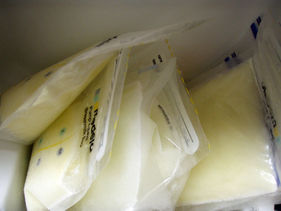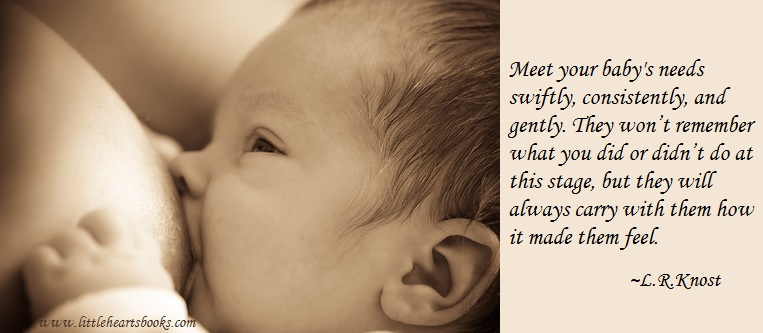The Gift of Breastfeeding!
[Portions reprinted from Two Thousand Kisses a Day: Gentle Parenting Through the Ages and Stages by L.R.Knost. Whispers Through Time: Communication Through the Ages and Stages of Childhood, and The Gentle Parent: Positive, Practical, Effective Discipline also available on Amazon and through other major retailers.]
A newborn baby has only three demands. They are warmth in the arms of its mother, food from her breasts, and security in the knowledge of her presence. Breastfeeding satisfies all three. ~Grantly Dick-Read
Breastfeeding, like exercise, is one of the most highly preventive and cost-effective ways to protect the health of mothers, babies, the population, and the planet. Yet, the U.S. has one of the lowest rates of breastfeeding among industrialized countries and one of the highest rates of infant mortality. Our rates of breast cancer, diabetes, obesity, and asthma are growing at an alarming pace. It is estimated that normal breastfeeding rates could save the U.S. $13 billion and 911 lives annually on health care & associated costs for just 10 diseases.
Sweet, milky giggles
Baby’s trusting eyes look up
Forging bonds that last. R.H.
Excellent information from Kellymom about how to get a comfortable latch and position for nursing.
The Guggie Daily: God Wants to Breastfeed His People
 The Normal Newborn & Why Breastmilk isn’t Just Food
The Normal Newborn & Why Breastmilk isn’t Just Food
Breast Milk~The Original Soul Food
We have breasts to feed our young but we also have brains that tell us this is more than nutrition.. this is comfort, bonding, the original Soul food!
“Breastmilk, unlike formula is a living organism. When one looks at breastmilk under a microscope there is plenty of movement. Contrast that with formula, where the petri dish reveals a stagnant state. Formula is dead. It cannot change to meet the needs of a particular infant. It does not change during a feed…”
Lovely thoughts from a breastfeeding mama.
 What Kind of Woman Breastfeeds a Toddler?
What Kind of Woman Breastfeeds a Toddler?
An amazing array of women from every walk of life who share their breastfeeding journeys~Compiled and shared by The Mule
Low Milk Supply~Set up for failure
SIDS (Sudden Infant Death Syndrome), Asthma, Childhood Leukemia, Diabetes, Gastroenteritis, Otitis Media (ear infections), LRTIs (pneumonia, bronchitis, etc), Necrotizing Enterocolitis, Obesity, and other potentially life-altering or fatal conditions…
If you knew that there was one medicine or vitamin or herbal supplement that has been proven, PROVEN, beyond a shadow of a doubt in study after study by mainstream, published, respected doctors, researchers, and scientists, to significantly reduce the risk of every single one of those things listed above, would you give it to your baby?
Breast cancer, Ovarian Cancer, Diabetes, Heart Disease, Obesity…
What if that wonder drug could also drastically reduce your risk of each of these health threats?
13 billion…BILLION…dollars lost in the U.S. alone in PREVENTABLE medical costs.
If you knew that there was one thing you could do to save billions of taxpayer dollars that could go to feed the hungry, house the homeless, research cures for other devastating diseases, provide health care to the poor, would you do it?
The Journal of the American Academy of Pediatrics released a study in April of 2010 detailing just what that one medicine/vitamin/herbal supplement is…and the ‘miracle drug’ is  none other than BREASTFEEDING. The study concluded that, “The United States incurs $13 billion in excess costs annually and suffers 911 preventable deaths per year because our breastfeeding rates fall far below medical recommendations.” And those numbers are only based on breastfeeding benefits for the first six months of life! The World Health Organization, American Academy of Pediatrics, Centers for Disease Control, and others recommend breastfeeding for the first two years of a child’s life. Imagine the tally if the researchers had looked at the little lives lost and billions of dollars spent unnecessarily in a two year breastfeeding scenario instead of a six month scenario!
none other than BREASTFEEDING. The study concluded that, “The United States incurs $13 billion in excess costs annually and suffers 911 preventable deaths per year because our breastfeeding rates fall far below medical recommendations.” And those numbers are only based on breastfeeding benefits for the first six months of life! The World Health Organization, American Academy of Pediatrics, Centers for Disease Control, and others recommend breastfeeding for the first two years of a child’s life. Imagine the tally if the researchers had looked at the little lives lost and billions of dollars spent unnecessarily in a two year breastfeeding scenario instead of a six month scenario!
In 2009, the CDC released a Breast Feeding Report Card which showed that, while 74% of women start off breastfeeding, only 33% continue to three months and just 14% are exclusively breastfeeding by six months.
Clearly, then, the majority of women at least begin with the desire to breastfeed!
So why are breastfeeding rates so dismal in the United States? For one thing, U.S.hospitals scored a low D (63%) in their compliance with recommendations to provide breastfeeding  support for women in a 2007 CDC survey. One issue is that hospitals routinely send home ‘failure’ packets of formula with new mommies “just in case,” which sit temptingly in pretty, complementary diaperbags waiting for the inexperienced new mommy to face her first breastfeeding hurdle, her first feeding worry, her first sleep-deprived need to find any reassurance that she’s doing a good job feeding her baby during those first weeks. Another issue is that hospital lactation consultants are typically stretched far too thinly amongst many patients and are only available for a few minutes to get new mommies started, and then most insurance companies don’t cover follow-up lactation support after mommies leave the hospital. Other issues in the hospital include delaying the new mommy’s ability to begin breastfeeding immediately by removing the baby to a warming bed instead of laying the baby on the mommy’s tummy, and too early interventions such as eye ointment, bathing the baby, and taking the baby to the nursery to be evaluated in the absence of medical necessity.
support for women in a 2007 CDC survey. One issue is that hospitals routinely send home ‘failure’ packets of formula with new mommies “just in case,” which sit temptingly in pretty, complementary diaperbags waiting for the inexperienced new mommy to face her first breastfeeding hurdle, her first feeding worry, her first sleep-deprived need to find any reassurance that she’s doing a good job feeding her baby during those first weeks. Another issue is that hospital lactation consultants are typically stretched far too thinly amongst many patients and are only available for a few minutes to get new mommies started, and then most insurance companies don’t cover follow-up lactation support after mommies leave the hospital. Other issues in the hospital include delaying the new mommy’s ability to begin breastfeeding immediately by removing the baby to a warming bed instead of laying the baby on the mommy’s tummy, and too early interventions such as eye ointment, bathing the baby, and taking the baby to the nursery to be evaluated in the absence of medical necessity.
But, even so, 74% of American women triumph over these issues and leave the hospital having established breastfeeding with their newborn. So what happens then? Why does that number fall so dramatically by more than half to 33% by three months and by nearly 80% down to only 14% of women by six months?
Some contributing factors are mothers who must return to workplaces which don’t support breastfeeding with long lunches to return home to breastfeed or flexible schedules which allow for frequent pumping, and insurance companies which don’t cover lactation consultants or breast pumps, and, in a small percentage of cases, health issues with the mother or baby.
All of these issues certainly need to be addressed by hospitals, insurance companies and businesses, and the government can be of service in these areas by providing tax incentives, education, and support.
But there are still more subtle issues that negatively affect breastfeeding rates. Some of these include older mothers relishing in telling horror stories about cracked nipples, thrush, clogged ducts, etc; pediatricians who use weight charts based on formula fed infants and scaring new mothers into thinking their babies aren’t gaining enough weight; and the pervasive, but false, belief that formula is just as good as breastmilk for babies.
One issue, though, that seems to crop up far more than others is low milk supply. Somehow, even though mothers’ bodies are capable of miraculously growing a human being for nine months and bringing that precious new life into the world, those same life-giving bodies are failing to provide life-giving (and saving!) nutrition to those precious babies. Why? For some, it is certainly just fear-mongering by those pediatricians using the formula fed babies’ charts or by grandmothers who believe that all babies should be chubby that lead new mothers to believe they have low supply, but there does seem to be an ever-increasing number of babies legitimately labeled as failure-to-thrive with low milk supply labeled the cause.
that precious new life into the world, those same life-giving bodies are failing to provide life-giving (and saving!) nutrition to those precious babies. Why? For some, it is certainly just fear-mongering by those pediatricians using the formula fed babies’ charts or by grandmothers who believe that all babies should be chubby that lead new mothers to believe they have low supply, but there does seem to be an ever-increasing number of babies legitimately labeled as failure-to-thrive with low milk supply labeled the cause.
One crucial piece of false information can be blamed for the vast majority of low milk supply issues in the absence of a documented medical cause.
That false information? New mothers are told their babies should sleep through the night.
That is one of the most pernicious lies ever foisted on new parents. Babies biologically should NOT sleep through the night. Not only is the deep sleep required to sleep through the night actually a recognized factor in SIDS deaths, but babies who sleep through the night are also not nursing to stimulate breastmilk production, thus their mother’s milk begins to dry up. Clearly, that’s not a healthy biological design!
Here is a picture of what this vicious cycle can look like:
Lydia battles the lack of breastfeeding support at the hospital and triumphantly goes home a breastfeeding mother, formula ‘fail’ packet tucked securely in the chic little complementary diaperbag in the trunk along with stacks of information about how healthy formula is and lots of lovely formula coupons.
 She gets her precious baby home and settles in for her twelve week ‘babymoon’ before she has to return to work because that’s all the time her work allows. She’s already nervous about how she’s going to handle the return to work, leaving her sweet baby in someone else’s care, and trying to pump to maintain her milk supply and provide milk for her baby while she’s gone, but she pushes those thoughts aside and suppresses the anxiety as much as she can. The first few nights are pretty easy because her baby sleeps most of the time, so Lydia is able to get a little rest in between feedings. She reads up on some parenting advice in a couple of popular magazines and discovers that she should be working to schedule her baby’s feedings at 3-4 hour intervals. That makes her feel a bit worried because she’s just been feeding her baby whenever he seemed hungry, so she gets a notebook out and writes down a schedule.
She gets her precious baby home and settles in for her twelve week ‘babymoon’ before she has to return to work because that’s all the time her work allows. She’s already nervous about how she’s going to handle the return to work, leaving her sweet baby in someone else’s care, and trying to pump to maintain her milk supply and provide milk for her baby while she’s gone, but she pushes those thoughts aside and suppresses the anxiety as much as she can. The first few nights are pretty easy because her baby sleeps most of the time, so Lydia is able to get a little rest in between feedings. She reads up on some parenting advice in a couple of popular magazines and discovers that she should be working to schedule her baby’s feedings at 3-4 hour intervals. That makes her feel a bit worried because she’s just been feeding her baby whenever he seemed hungry, so she gets a notebook out and writes down a schedule.
Over the next couple of weeks, things get a bit more difficult as she walks and bounces and rocks her baby, anxiously watching the clock until she can satisfy her baby’s cries and nurse him. Her baby seems to be crying more and more often. As her stress level increases, she pours over parenting books and magazines, trying to find solutions to her baby’s distress. Over and over again, she reads that babies need to be on a strict schedule and be trained to self-soothe and sleep through the night.
Lydia desperately wants to be a good mother, so she braces herself and begins to stop nursing before her baby falls asleep and laying him down on his own to fall asleep alone. She cries listening to his screams, but confines herself to occasionally stepping into the room to pat him gently for a moment, tears streaming down her cheeks as she leaves him to cry himself to sleep.
A few weeks later, her pediatrician expresses some concern about her baby’s slowing weight gain, but cheerfully assures her that she has just become a ‘midnight snack’ for her little one and needs to begin cutting out night feeds so her baby can learn to sleep through the night.Lydia feels sick to her stomach as she leaves the doctor’s office, but is determined to put her feelings aside and be a good mother.
Lydia experiences some engorgement issues for the first few nights, but the discomfort is nothing compared her heartbreak at listening to her baby cry. Over the next few weeks, she notices a perceptible decrease in the volume of her breasts and her let down reflex feels weak. Her fears are confirmed when she takes her baby back to the pediatrician who is alarmed to find that Lydia’s baby has actually lost weight. Lydia leaves the pediatrician’s office with a diagnosis of failure-to-thrive for her precious baby, low milk supply for her, and a feeling of utter failure as a mother.
At home, Lydia searches for the chic little diaperbag with the formula ‘failure’ packet and mixes up a bottle, tears falling as she becomes just another statistic.
~~~~~~~~~
Feeling forced to ignore her natural mothering instincts because of prevailing mainstream parenting practices, Lydia’s anxiety steadily increased in her baby’s first weeks, negatively affecting her milk supply. Nursing on a schedule prevented her from receiving the stimulation of milk production inherent in the frequent suckling of a baby allowed to nurse on demand. But the breastfeeding coffin was sealed when night nursing ended and with it the loss of hours and hours of milk stimulation resulting in that modern epidemic ~ low milk supply.
 Related links:
Related links:
Love in the Time of Cosleeping
And Baby Makes Three~Surviving the first three months with a newborn!
Breastfeeding, Babywearing, and Bouncing Back into Shape after Baby
A Boy, A Girl, and A Baby~Journey to Gentle Parenting
Babywearing Basics Resource Guide
Practical Gentle Discipline Guide
 Award-winnning author, L.R.Knost, is the founder and director of the children's rights advocacy and family consulting group, Little Hearts/Gentle Parenting Resources, and Editor-in-Chief of Holistic Parenting Magazine. Books by L.R.Knost include Whispers Through Time: Communication Through the Ages and Stages of Childhood ; Two Thousand Kisses a Day: Gentle Parenting Through the Ages and Stages ; The Gentle Parent: Positive, Practical, Effective Discipline ; and Jesus, the Gentle Parent: Gentle Christian Parenting the first four books in the Little Hearts Handbook gentle parenting series, and children’s picture books Petey’s Listening Ears and the soon-to-be-released Grumpykins series.
Award-winnning author, L.R.Knost, is the founder and director of the children's rights advocacy and family consulting group, Little Hearts/Gentle Parenting Resources, and Editor-in-Chief of Holistic Parenting Magazine. Books by L.R.Knost include Whispers Through Time: Communication Through the Ages and Stages of Childhood ; Two Thousand Kisses a Day: Gentle Parenting Through the Ages and Stages ; The Gentle Parent: Positive, Practical, Effective Discipline ; and Jesus, the Gentle Parent: Gentle Christian Parenting the first four books in the Little Hearts Handbook gentle parenting series, and children’s picture books Petey’s Listening Ears and the soon-to-be-released Grumpykins series.















Pingback: » A Return to Childhood Little Hearts/Gentle Parenting Resources
Pingback: » Co-sleeping Safely~Is it possible? Decide for yourself! Little Hearts/Gentle Parenting Resources
Pingback: » The Art of Motherhood Little Hearts/Gentle Parenting Resources
Pingback: » Baby Talk Little Hearts/Gentle Parenting Resources
Pingback: » Love in the Time of Cosleeping Little Hearts/Gentle Parenting Resources
Pingback: » Shared Journeys~Attachment Parenting Little Hearts/Gentle Parenting Resources
Pingback: » Picky Eater? Here’s Help! Little Hearts/Gentle Parenting Resources
Pingback: » Little Hearts Fit & Fabulous Guide Little Hearts/Gentle Parenting Resources
Pingback: » The Story of Us~25 Years and Counting! Little Hearts/Gentle Parenting Resources
Pingback: » Ten Steps to Surviving the first three months with a newborn! Little Hearts/Gentle Parenting Resources
Pingback: » Where are all the Black Babies? Abortion, Eugenics & Genocide Little Hearts/Gentle Parenting Resources
Pingback: In honor of World Breastfeeding Week… | New Mom, New City
Pingback: » The Cost of Being Mom Little Hearts/Gentle Parenting Resources
Pingback: » 300+ Nicknames for Your Babykins…Doodlebug…Snugglebunny… Little Hearts/Gentle Parenting Resources
Pingback: » Homemade Infant Formula~An Alternative to Commercial Formulas? Little Hearts/Gentle Parenting Resources
Pingback: » 11 Reasons Breastfeeding my Toddler ROCKS! Little Hearts/Gentle Parenting Resources
Pingback: Crazy, Beautiful, Wonderful Life! | Little Hearts/Gentle Parenting Resources
Pingback: Baby on the Way! 25 Tips to Prepare Children for a New Sibling | Little Hearts/Gentle Parenting Resources
Pingback: Custom Cosleeper Sidecar!!! | Little Hearts/Gentle Parenting Resources
Pingback: Babywearing Basics Resource Guide | Little Hearts/Gentle Parenting Resources
Pingback: I Spy…A Bad Mom | Little Hearts/Gentle Parenting Resources